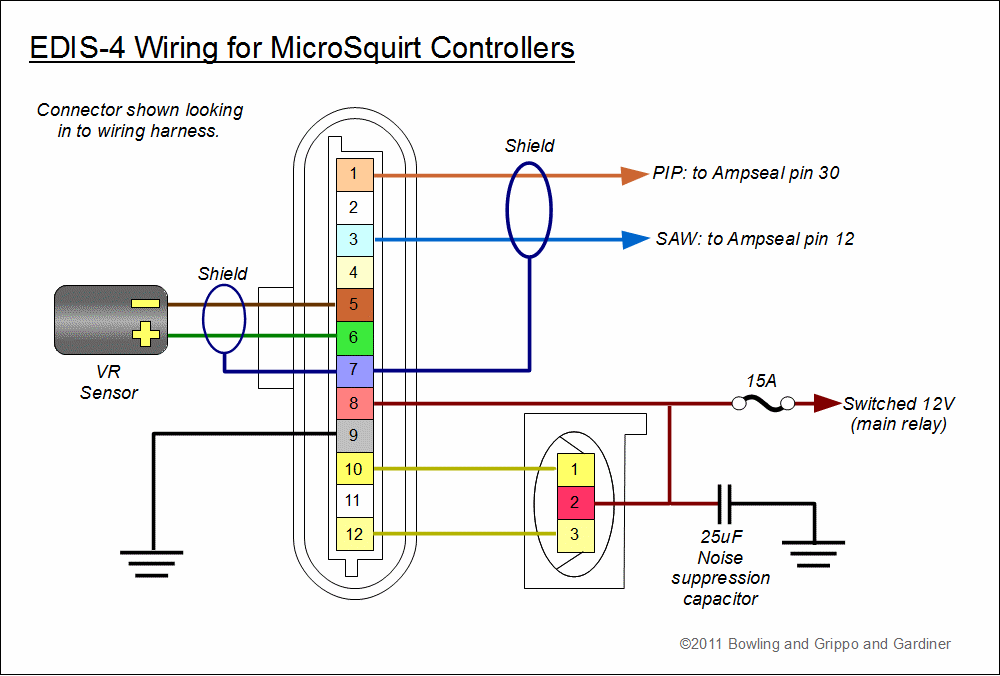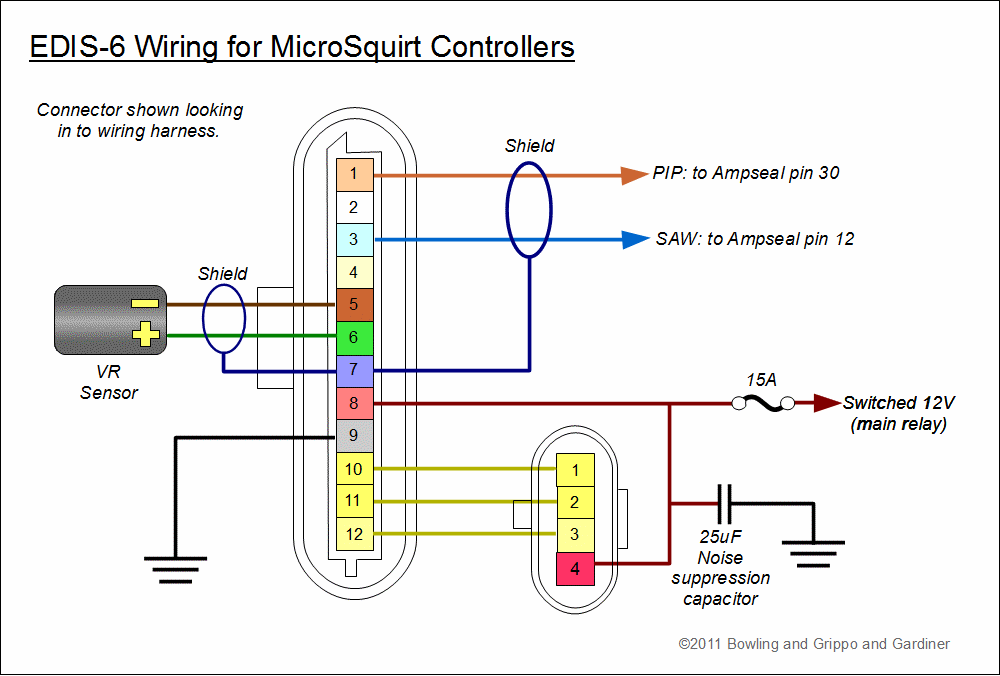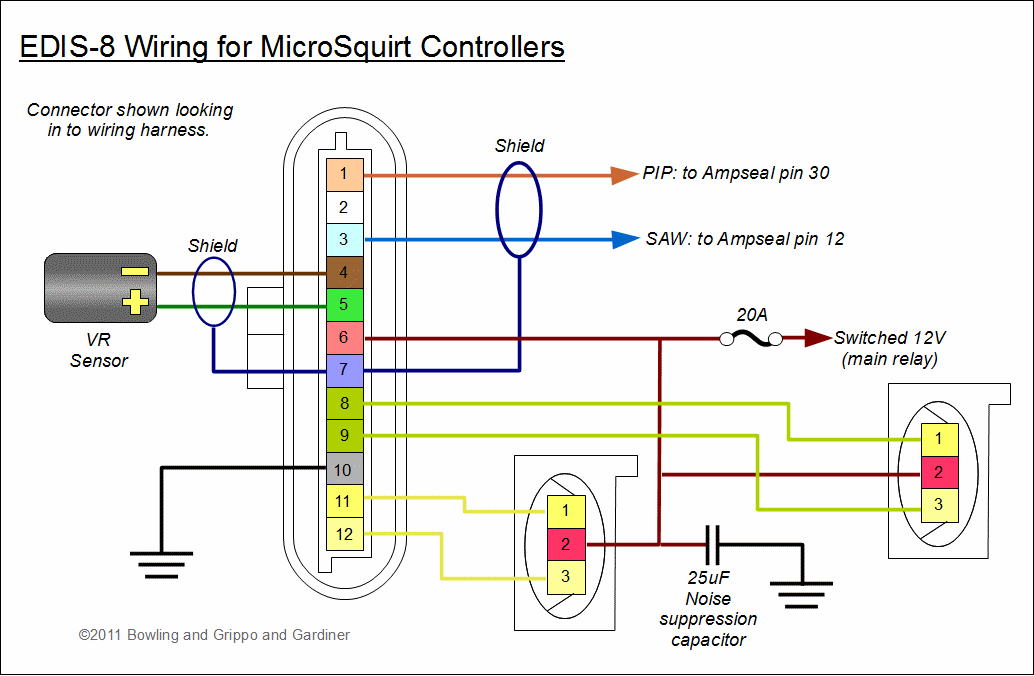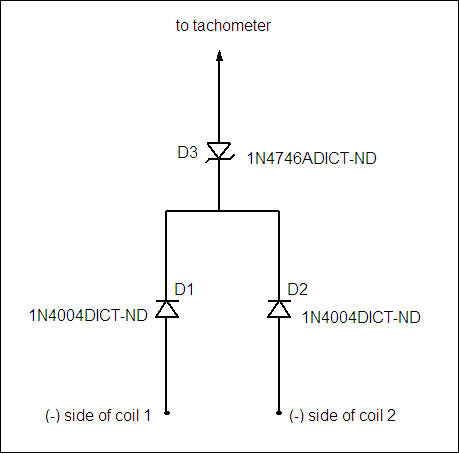

Ford's Electronic Distributorless Ignition System (EDIS) is an ignition system that does NOT require a cam position signal. It can function with just a variable reluctor crank position sensor and a 36-1 tooth wheel (36-1 means '36 teeth minus one', and refers to 36 evenly spaced teeth, one of which has been removed). (For a custom 36-1 wheel for a small block Chevrolet, see: www.megamanual.com/ms2/36-1.htm)
Because it doesn't need a camshaft position sensor, EDIS is a particularly easy way to replace distributor ignitions when retrofitting older engines with a modern computer programmable ignition.
The EDIS system is made up of:
The EDIS-8 & EDIS-6 modules are fairly common on eBay, and are also available from a number of manufacturers for about $180. The EDIS-4 module can be found for around $100. Here are some part numbers:
| AC Delco | 19017159, F1945 | 19017168 | 19017160, F1946 |
| Autotune | PT6909 | PT6910, PT6912, PT7088, PT7095 | PT7089, PT7092, PT7093 |
| BWD | CBE114 | CBE115, CBE116, CBE52, CBE59 | CBE53, CBE56, CBE57 |
| GP Sorenson | EL162 | EL375, EL378 | EL174 |
| Motorcraft | DY630, F0CF12A359AB, F0CF12A359AC, F1CZ12A297A, F1CZ12A297B, F1CZ12K072A, F1CZ12K072B | 90GB12K072AB, DY629, DY657, DY680, DY682, DY689, DY724, DY727, F07F12K072BA, F0TZ12K072B, F0TZ12K072BA, F1TZ12K072B, F1TZ12K072BA, F4SZ12K072B, F4ZF12K072AC,F4ZF12K072BB, F4ZF12K072BC, F4ZZ12K072A, F4ZZ12K072B | DY644, DY687, DY726, DY755A, DY887, F1AF12K072AC, F1AF12K072AD, F1AZ12K072A, F3LF12K072AA, F3LY12K072A, F4SZ12K072A, F5SF12K072AA, F5SZ12126AA, F5SZ12K072AA |
| NAPA-Echlin | TP500, TP515 | TP504, TP507, TP513 | TP508 |
| Niehoff | FF424A | FF420, FF424C, FF424F, FF425E | FF421, FF425A, FF426A |
| Standard | LX239 | LX254, LX256 | LX243 |
| Wells | F140, F157 | F142, F158, F159, F169 | F143, F144 |
If you go to a salvage yard for EDIS modules, they are usually located in the engine compartment on the driver's side inner fender. The modules have a EDIS-4 (or EDIS-6 or EDIS-8, depending on number of cylinders) sticker on them. Try to take the connector as well, as well as the ignition coil pack(s) and connectors. You can also obtain used units from the salvage web at www.car-part.com.
The EDIS can be found on:
The EDIS 4 and 8 cylinder coil packs are available from Accel under number 140018 ($54.95 each from Summit Racing)
The EDIS system handles the complete task of crank/ignition synchronization as well as current control for the wasted-spark coils. It sends just one signal (PIP) to your MicroSquirt® controller, and receives just one signal (SAW) back. The desired amount of ignition advance is generated by your MicroSquirt® controller. The interface between the EDIS and your MicroSquirt® controller is extremely simple. There is one output signal (PIP) and one input signal (SAW) from the EDIS module your MicroSquirt® controller.
On all engines, the complementary coils are connected to the cylinders that are 360° (i.e., ½ of a 720° engine 'cycle') apart in the firing order. For example, the firing order for HO 5.0L and 351 engines is 1-3-7-2-6-5-4-8. Connect cylinders 1 and 6 to the same coil, 3 and 5 to another coil, 7 and 4 to another coil, and 2 and 8 to the remaining coil. Note that the coils are packages in two groups of two coils (each of which fires 2 cylinders) in V8 applications.
The operation the EDIS system is very simple. The crankshaft is fitted with a 36-tooth wheel, with one tooth missing. The missing tooth indicates the exact position of the crankshaft to the EDIS. The EDIS system is a wasted-spark setup (i.e. two spark plugs fire which are separated by 360 "cycle-degrees" of a 4-cycle engine), so there is no synchronization with the camshaft. This means that one cylinder has its spark plug firing during the valve overlap period near top dead center, but because the pressures are so low and the charge is diluted by the exhaust gases, no ignition occurs. This spark is 'wasted' on a cylinder that isn't firing, and EDIS is referred to as a 'wasted spark' ignition system.
Near the crank wheel is a Variable-Reluctance (VR) sensor - this sensor produces a bipolar signal. The VR sensor is pointed at the center of the crank wheel, with a 0.030 to 0.060 inch gap (0.75 mm to 1.5 mm) to the crank wheel teeth.
The VR sensor and 36-1 crank trigger wheel must be set in the correct relationship to each other. With the engine at TDC for cylinder #1, this relationship is:
Note that you have a choice where to place the sensor, IF you can shift the wheel. It is a good idea to build the VR sensor bracket so that you have a degree of radial adjustment (closer/farther from the wheel) and angular adjustment (closer/further from TDC). Also, bear in mind that most automotive engines rotate clockwise when viewed from the front, except many Honda engines.
With the above configuration, the EDIS module will fire the ignition at 10° BTDC, unless the module receives a Spark Angle Word (SAW) command. The 10° advance is constant, regardless of RPM. This functions as a limp-home mode; if the module doesn't receive SAW commands from your MicroSquirt® controller, it will generate a usable (but not optimal) 10° BTDC of ignition advance.
To test the VR sensor alignment, run the EDIS in limp home mode. This can be done by disconnecting the SAW/PIP plug, or disconnecting your MicroSquirt® controller (or its power).
Start your engine and check that the timing is exactly 10° BTDC with a timing light on cylinder #1. If the timing isn't 10° BTDC, adjust the position of your VR sensor until the timing is as close to 10° BTDC as you can get it. Note that at very low rpms (less than 400) the EDIS with no SAW input will start at almost TDC and as rpm increases towards 400 the ignition point will approach 10° BTDC; it will be stable above that engine speed. So the engine must be running to check the timing, cranking won't work. Don't forget to reconnect the SAW/PIP plug when you are done, or you will have NO timing advance and your engine will run poorly and inefficiently.
A significant part of the whole EDIS module is the multiple-coil drivers. First thing is that the EDIS module has the actual ignition coil driver built-in - the driver is not part of the Ford wasted-spark coil pack. The coil packs are just standard ignition coils, and could in theory be substituted with other coil-only packs. The EDIS-8 module has four coil drive channels - EDIS 6 has three, and the EDIS-4 has two. The EDIS module handles the dwell time automatically, depending on commanded advance and RPM - another feature which makes the EDIS one of the easiest to use DIY setups.
The EDIS ignition system is rugged. The module mounts under-hood and will survive engine-bay temperatures, water, freezing, etc. And with only two wires going back to the your MicroSquirt® controller box (PIP and SAW), wiring is extremely easy.
Installing the Ford EDIS System
Note that the PIP signal from the EDIS module to MegaSquirt® is like a Hall sensor signal (positive only square wave). As a result, you use the Hall input circuit, On a V3 board, jumper D1 and D2 (or install jumpers in their place when assembling).
The SAW signal from your MicroSquirt® controller to the module comes out on pin #17 of the 40 pin socket (labeled IGN), and is connected to the 5th hole of the JP1 socket (pin 8 of the MC9S12C64) on V2.2 boards (JS10 on V3.0 boards). The PIP signal goes to your MicroSquirt® controller via the DB37 pin 24. This is connected to pin 14 of the 40 pin socket (IRQ), and pin #1 of the MC9S12C64 processor.
To install EDIS with your MicroSquirt® controller, you connect:
Here are the EDIS external wiring diagrams for the EDIS4, EDIS-6 and EDIS-8:



Note that the EDIS-4 and EDIS-8 key are similar, but swapped from end to end. Do not attempt to connect them, you will ruin the module, wiring, and/or coil packs. In all case the clip is the most useful guide to the pin numbering. Pin #1 is usually marked on the connector.
Spark Plug Wiring
There are a number of principles to wiring the spark plug leads to the coils, and a number of 'gotchas'.
Note that most timing lights that let you set the timing with a dial and read the alignment of fixed TDC marks with the strobe will not work with EDIS. This is because these timing lights use the time between sparks to compute the engine speed and advance, but the EDIS wasted spark is giving sparks twice as often as the timing light expects for a given rpm. If you have a 'dial back' timing light, set the dial to zero and use a degreed damper or timing tape to view the advance.
In TunerStudioMS, set:
Set the predictor algorithm option to 'last interval'.
DO NOT set the missing tooth settings to 36-1 - set the Trigger Wheel Teeth to zero - the EDIS module takes care of the 36-1 wheel - your MicroSquirt® controller sees it as a regular distributor.
For your dash tachometer, you have a few choices, :

If you are running EDIS on a Ford engine, you may also be interested in controlling the PWM Idle vale: IAC.htm#pwm